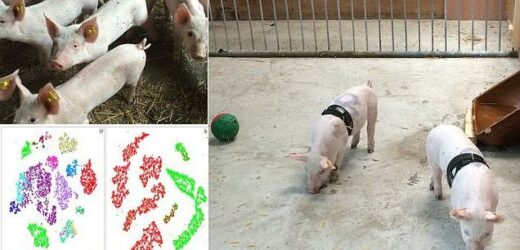Scientists translate PIG GRUNTS into actual emotions for the first time in breakthrough that could one day let us communicate with swine
- Researchers trained an algorithm with 7,414 recordings of pig calls from 411 pigs
- The audio included pig noises that were made in positive and negative situations
- Farmers could use an app with the algorithm to improve mental health of piggies
In a potential breaththrough for monitoring animal wellbeing, scientists say they have translated pig grunts into emotions for the first time.
Researchers trained an artificial intelligence (AI) algorithm with 7,414 recordings of pig noises, gathered throughout the life stages of 411 pigs – including slaughter.
The algorithm could potentially be used to build an app for pig farmers that detects whether the animals are happy just from the noise they’re making.
With enough data to train the algorithm, the method could also be used to better understand the emotions of other mammals, experts say.
Using thousands of acoustic recordings gathered throughout the lives of pigs, from their births to deaths, an international team of researchers is the first in the world to translate pig grunts into actual emotions across an extended number of conditions and life stages
This image shows the classification of pig calls to ‘valence and context’, based on the algorithm. Triangles indicate negative vocalisations, while circles indicate positive ones
Typical signs of positive and negative emotions in pigs
Typical signs of negative emotions in pigs include:
– Standing still
– Emitting a lot of vocalizations
– Trying to escape
Typical signs of positive emotions in pigs include:
– Exploring their surroundings
– Having their ears postured forward
The research was led by the University of Copenhagen, the ETH Zurich and the France’s National Research Institute for Agriculture, Food and Environment (INRAE).
‘We have trained the algorithm to decode pig grunts,’ said study author Dr Elodie Briefer at the University of Copenhagen.
‘Now we need someone who wants to develop the algorithm into an app that farmers can use to improve the welfare of their animals.’
Researchers say the algorithm can decode whether an individual pig is experiencing a positive emotion (‘happy’ or ‘excited’), a negative one (‘scared’ or ‘stressed’) or somewhere in between.
The recordings were collected from both commercial and experimental scenarios, either associated with a positive and negative emotion, from birth until death.
Positive situations included, for example, those when piglets suckle from their mothers or when they are united with their family after being separated.
The emotionally negative situations included missed nursing, short social isolation, piglet fights, piglet crushing by the mother, castration and handling and waiting in the slaughterhouse.
In experimental stables, the researchers also created various mock scenarios for the pigs, designed to evoke ‘more nuanced emotions’ in the middle of the spectrum.
These included an arena with toys or food and a corresponding arena without any stimuli.
Pigs are capable of learning how to play simple video games, scientists demonstrated, showing the animals to be more intelligent than was thought.
In 2021, US researchers taught pigs to manipulate a joystick with their snouts, moving a cursor on a screen around to reach one of up to four target walls.
Each pig displayed some conceptual understanding of the game and the connection between the movement of the joystick control and the cursor.
Read more: Experts teach pigs to play video games
The researchers also placed new and unfamiliar objects in the arena for the pigs to interact with.
Along the way, the pigs’ calls, behaviour and heartrates were monitored and recorded when possible.
The researchers then analysed the audio recordings to discern the positive situations and emotions from the negative ones.
As already revealed in previous research, there are more high-frequency calls from pigs (such as screams and squeals) in negative situations.
At the same time, low-frequency calls (such as barks and grunts) occurred both in situations where the pigs experienced positive or negative emotions.
With an even more thorough analysis of the sound files, the team found a new pattern that revealed what the pigs experienced in certain situations in even greater detail.
‘There are clear differences in pig calls when we look at positive and negative situations,’ said Dr Briefer.
‘In the positive situations, the calls are far shorter, with minor fluctuations in amplitude. Grunts, more specifically, begin high and gradually go lower in frequency.
Researchers trained an artificial intelligence (AI) algorithm with 7,414 recordings of pig noises, gathered throughout the life stages of 411 pigs – including slaughter
‘By training an algorithm to recognise these sounds, we can classify 92 per cent of the calls to the correct emotion.’
Although it is widely accepted that the mental health of livestock is important for their overall well-being, animal welfare today focuses primarily on the physical health of livestock.
The researchers hope their algorithm might pave the way for a new platform for farmers to keep an eye on their animals’ psychological well-being.
The findings have been published today in Scientific Reports.
HAPPY PIGS OINK MORE! GRUNTS AND SQUEALS HELP SHOW OFF PIGGY PERSONALITIES AND HOW CONTENT THEY ARE IN THEIR PENS
There’s more to a pig’s oink than meets the ear, with happier porkers making more noise than grumpy ones, scientists found in 2018.
The academics, from the universities of Lincoln and Belfast, studied 72 male and female juvenile pigs.
Half of the pigs were placed in spacious, ‘enriched’ pens with straw bedding.
The other half were put in more compact ‘barren’ pens, with partially slatted concrete floors which were in accordance with UK welfare standards.
To test the pig’s personalities, the researchers carried out two tests.
One involved placing a pigs in a pen for five minutes with objects they had not encountered before – these were a large white bucket or an orange traffic cone.
Their behaviour – including their grunts – were then measured.
The tests were repeated a fortnight later to see if the pigs’ behaviour was consistent.
The study found pigs with more ‘proactive’ personality types – who were keener to explore their environment – produced more grunts than the ‘reactive’ animals.
It also found male pigs kept in the lower-quality conditions made fewer grunts than those in the enriched pens.
Dr Lisa Collins, a specialist in animal health, behaviour and welfare epidemiology in the School of Life Sciences at the University of Lincoln, said: ‘The domestic pig is a highly social and vocal species which uses acoustic signals in a variety of ways; maintaining contact with other group members while foraging, parent–offspring communication, or to signal if they are distressed.
‘The sounds they make convey a wide range of information such as the emotional, motivational and physiological state of the animal. For example, squeals are produced when pigs feel fear, and may be either alerting others to their situation or offering assurance.
‘Grunts occur in all contexts, but are typical of foraging to let other members of the group know where they are.’
Source: Read Full Article





